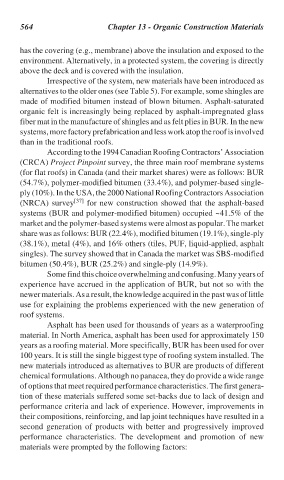Page 597 - Handbook of Thermal Analysis of Construction Materials
P. 597
564 Chapter 13 - Organic Construction Materials
has the covering (e.g., membrane) above the insulation and exposed to the
environment. Alternatively, in a protected system, the covering is directly
above the deck and is covered with the insulation.
Irrespective of the system, new materials have been introduced as
alternatives to the older ones (see Table 5). For example, some shingles are
made of modified bitumen instead of blown bitumen. Asphalt-saturated
organic felt is increasingly being replaced by asphalt-impregnated glass
fiber mat in the manufacture of shingles and as felt plies in BUR. In the new
systems, more factory prefabrication and less work atop the roof is involved
than in the traditional roofs.
According to the 1994 Canadian Roofing Contractors’ Association
(CRCA) Project Pinpoint survey, the three main roof membrane systems
(for flat roofs) in Canada (and their market shares) were as follows: BUR
(54.7%), polymer-modified bitumen (33.4%), and polymer-based single-
ply (10%). In the USA, the 2000 National Roofing Contractors Association
(NRCA) survey [37] for new construction showed that the asphalt-based
systems (BUR and polymer-modified bitumen) occupied ~41.5% of the
market and the polymer-based systems were almost as popular. The market
share was as follows: BUR (22.4%), modified bitumen (19.1%), single-ply
(38.1%), metal (4%), and 16% others (tiles, PUF, liquid-applied, asphalt
singles). The survey showed that in Canada the market was SBS-modified
bitumen (50.4%), BUR (25.2%) and single-ply (14.9%).
Some find this choice overwhelming and confusing. Many years of
experience have accrued in the application of BUR, but not so with the
newer materials. As a result, the knowledge acquired in the past was of little
use for explaining the problems experienced with the new generation of
roof systems.
Asphalt has been used for thousands of years as a waterproofing
material. In North America, asphalt has been used for approximately 150
years as a roofing material. More specifically, BUR has been used for over
100 years. It is still the single biggest type of roofing system installed. The
new materials introduced as alternatives to BUR are products of different
chemical formulations. Although no panacea, they do provide a wide range
of options that meet required performance characteristics. The first genera-
tion of these materials suffered some set-backs due to lack of design and
performance criteria and lack of experience. However, improvements in
their compositions, reinforcing, and lap joint techniques have resulted in a
second generation of products with better and progressively improved
performance characteristics. The development and promotion of new
materials were prompted by the following factors:

